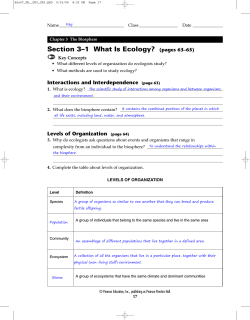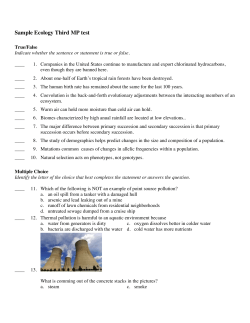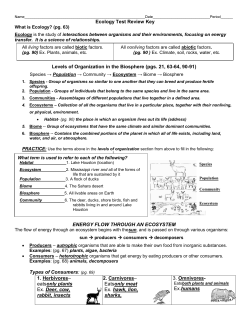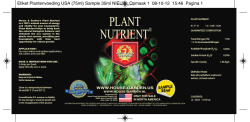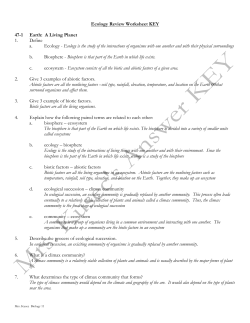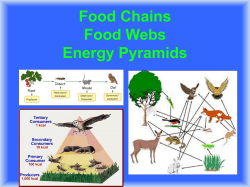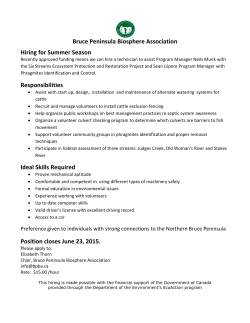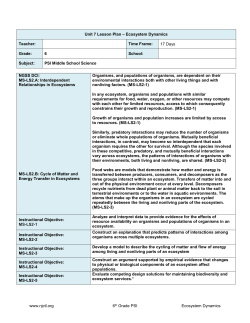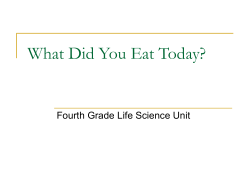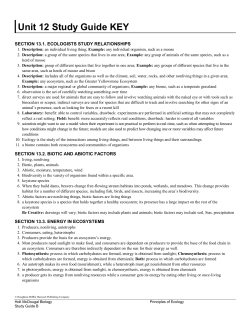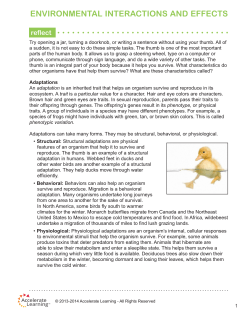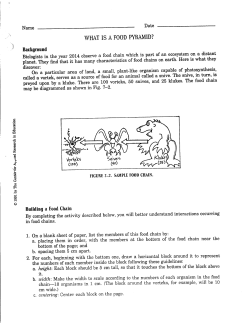
Document 240840
Section 3-l 63-d5) What Is Ecology? (pases This sectiottidentifiesthedifferentInels of organizationthat ecologists methodsusedto study ecology. study. It alsodescribes Interactions and Interdependence (page63) 1. What is ecology? 2. What does the biosphere contain? Levels of Organization (page 54) 3. \AIhy do ecologistsask questions about events and organisms that range in complexity from an individual to the biosphere? 4. Complete the table about levels of organization. LEVELSOF ORGANIZATION Level Definition Species A groupof individualsthat belongto the samespeciesand live in the same area @ e c -. o o Gommunity = .r = =. @ Ecosystem o @ @ A groupof ecosystemsthat havethe sameclimateand dominantcommunities Class Name Date 5. What is the highest level of organizationthat ecologistsstudy? 6s) Ecological Methods (page scientistsuseto conductmodem ecological 6. What arethe threebasicapproaches research? a. b. c. 7. Why might an ecologistset up an artificial environment in a laboratory? 8. Why are many ecological phenomena difficult to study? 9. Why do ecologistsmake models? 10. Is the following sentencetrue or false?An ecologicalmodel may consist of a mathematicalformula o < q; ? o Name Class Date 6r-7t\ Section 3-2 Energy Flow (pases This sectiottexplainszuhere theenergyfor life processes comes from. It also how energyJlows throughliaing systemsand how fficient the describes transferof energyis amongorgarismsin an ecosystem. Introduction (pagesz) 1. What is at the core of every organism'sinteractionwith the environment? Producers (pages 6z-68, 2. What sourceof energydo organismsusethat don't usethe sun'senergy? 3. What are autotrophs? a. Why are autotrophsalso called producers? 5. What do autotrophsdo during photosynthesis? 6. For eachof the following, write which kind of autotroph is the main producer. a. Land: b. Upper layers of ocean: c. Tidal flats and salt marshes: 7. What is chemosynthesis? 8. Where do bacteria that carry out chemosynthesislive? T -. a = Consum€fS (pages68-69) 9. Heterotrophs are also called 10. Plant and animal remains and other dead matter are collectiveiy called o d Date Class Name 1L. Complete the table about types of heterotrophs. TYPESOF HETEROTROPHS Type Examples Definition Cows, rabbits Herbivore Heterotrophthat eats animals Humans,bears,crow Omnivore Detritivore Decomposer Feeding Relationships (pages 6s-71') 12. How doesenergyflow throughan ecosystem? 13. Complete the table about feeding relationships. FEEDINGRELATIONSHIPS Relationship Description Food Chain FoodWeb 14. What does a food web link together? @ 15. What is a trophic level? 16. In a food web, what organismsmake up the first trophic level? < 17. What does a consumerin a food chain depend on for energy? Ecological Pyramids tp"g"s72-Ts, @ o L8. What is an ecologicalpyramid? 19. Why is it that only part of the energy stored in one trophic level is passedon to the next ievel? Name Class Date 20. Complete the energy pyramid by writing the source of the energy for the food web and how much energy is available to first-, second-,and third-level consumers. Heat Third-level consumers Second-level consumers First-level consumers 100%Producers 21. What is biomass? 22. What does a biomasspyramid represent? 23. What does a pyramid of numbers show? 24. Why can each trophic level support only about one tenth the amount of living tissue as the ievel below it? > Reading SkillPractice When your read about complex topics,writing an outline can help you organize and understand the material. Outline SectionT2by using the headings and subheadingsas topics and subtopics and then writing the most important details under eachtopic. Do your work on a separatesheetof paper. @ o @ 4 Date Class Name Section 3-3 Cycles of Matter (pases 74-80) amongtheliaingandnonliaingparts howmattercycles Thissection describes It alsoerplainshownutrientsareimportantin liaingsystems. ofanecosystem. za) Introduction (page 1. What arethe four elementsthat makeup over 95 percentof the body in most organisms? Recycling in the Biosphere (page24) 2. How is the movementof matterthroughthe biospheredifferentfrom the flow of energy? 3. Matter moves through an ecosystemrn 4. What do biogeochemical cycles connect? The Water Cycle (pase75) 5. Watercanenterthe atmosphereby evaporatingfrom the leavesof plantsin the processof 6. Circle the letter of each processinvolved in the water cycle. a. precipitation b. evaporation c. runoff d. fertilization Nutrient Cycles (pages 7G-Ts) 7. What are nutrients? E 8. What are the three nutrient cyclesthat play especially prominent roles in the biosphere? @ d.- .3 b. < 9? C € € E O 9. Why is carbon especialiy important to living systems? 10. What are three large reservoirs where carbon is found in the biosphere? a. As carbon dioxide gas in the b. As dissolved carbon dioxide in the c. As coal, petroleum, and calcium carbonate rock found 11. In what processdo plants use carbondioxide? Class Name Date 12. Why do all organisms require nitrogen? 13. Complete the table about the kinds of processesinvolved in the carbon cycle. INTHE CARBONCYCLE KINDSOF PROCESSES Kind Examples Biologicalprocesses Releaseof CO, to the atmosphereby volcanoes Mixedbiogeochemical processes Humanactivity L4. What is the main reservoir of nikogen in the biosphere? 15. What is nitrogen fixation? 16. \Atrhatis denitrification? 17. What role does denitrification play in the nitrogen cycle? 18. Circle the letter of each sentencethat is true about the phosphorus cycle. a. Phosphateis releasedas rocks and sedimentswear down. b. Plants absorb phosphate from the soil or from water. /a\ v E c. Phosphorus is abundant in the atmosphere. - d. Organic phosphate cannot move through food webs. -. 19. Why is phosphorus essentialto living things? a > =. @ @ Nutrient Limitation (page 8o) 20. What is the primaryproductivityof an ecosystem? 21. If a nutrient is in short supply in an ecosystem,how will it affect an organism? @ d Name Class Date 22. When is a substance called a limiting nutrient? 23. In the oceanand other saltwater environments, what is often the limiting factor? 24. What is the typical limiting factor in streams,lakes,and freshwater environments? 25. \Atrhenan aquatic ecosystemreceivesa Iarge input of a limiting nutrient, what is often the result, and what is this result called? 26. Why do blooms occur? WordWise Completethesentences by using oneof thescrambledwordsbelorn. dcreuorps mtssyceoe meiob ythnssieoemhcs aieoeoibgchmclyeccl ttnnreiu The processby which organisms use chemical energy to produce carbohydratesis A collection of all the organisms that live in a particular place, together with their physical environment, is a(an) A chemical substance that an organism requires to live is a(an) Autotrophs, which make their own food, are also called o o @ < U o ? o A group of ecosysternsthat have the same climate and dominant communities is a(an) A process in which elements, chemical compounds, or other forms of matter are passed from one organism to another and from one part of the biosphere to another is a(an)
© Copyright 2025
